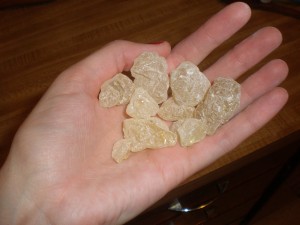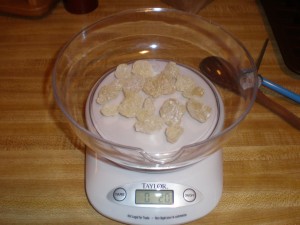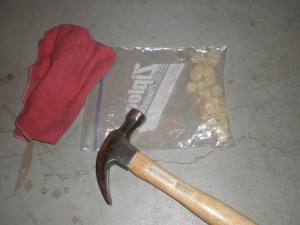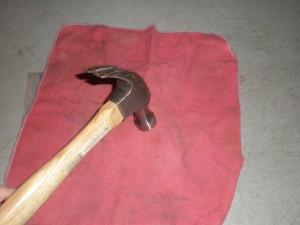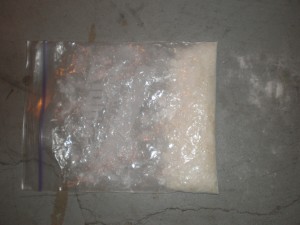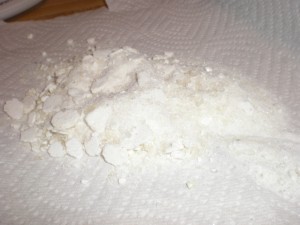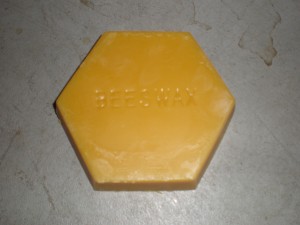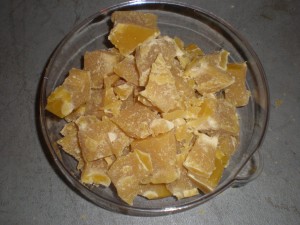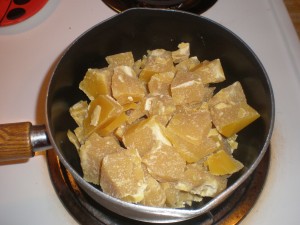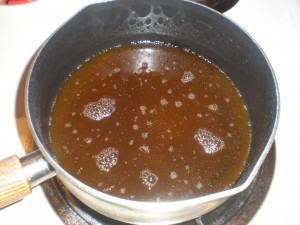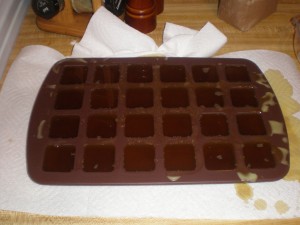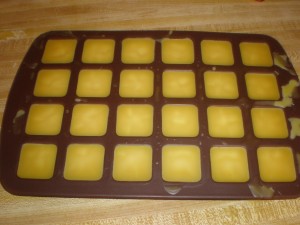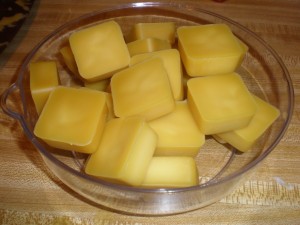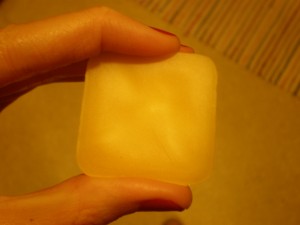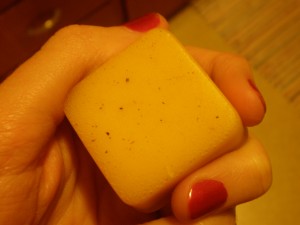Before I start into my blog post I thought I’d give some description about what encaustic medium is and what I use it for. Encaustic medium is just the beeswax mixed with damar resin, so it’s clear or slightly yellow depending on the type of wax. I use it as the first couple of coats on my boards to create a blank background I can scrape back to, to dilute my colored wax to varying layers of translucency, and as a collage medium. Most encaustic artists I’ve talked to mix their own medium because it’s cheaper than buying it pre-mixed and it’s supposed to be very easy to mix yourself. Then, if you want to make your own colored wax you simply add pigment powder to your encaustic medium.
Since Art Media, a small local art store where I’ve always bought my supplies, has been bought out by Blick which is a national chain, I’ve started making changes in where I buy my materials and thinking about I support local businesses. My goal is to buy local beeswax to mix my own medium and pigments, and recycle wood scraps from lumber stores as my boards. I bought a pound of beeswax at my local Portland Homestead Supply Co, a bag of damar resin crystals at Art Media before it was bought out, and some mixing supplies at the Goodwill, Micheal’s craft store, and True Value Hardware. I was ready to make medium.
My supply list:
- 1 pound beeswax
- 1 bag damar resin
- digital food scale (any small scale will do)
- silicone brownie tray (muffin tins are good too, but silicone ones are easiest)
- non-iron pot with pour spouts
- wooden spoon
- thermometer
- hammer or mallet
- ziploc bag
My encaustic books say that a good ratio is 8 parts beeswax to 1 part resin. Since I had a pound of wax I only needed 2 ounces of resin. Here is what the resin looks like:
The resin crystals still have bits of tree and plant debris in them and they’re pretty large to melt in the pot, so after weighing 2 ounces of crystals on my scale I put them into a ziploc bag, covered it with a cloth, and hammered the crystals into a powder. This makes it easier to pick out the large pieces of plant debris and the resin melts faster. Don’t worry about small pieces of dirt or debris, I took care of that at the end.
After the resin was crushed into a powder I realized I needed to break up the beeswax as well since it was still in a big block. I’ve heard that it’s easiest to break beeswax if you stick it in the freezer for a while first to make it brittle. I only put it in the freezer for a short time but it still helped a lot. It would have been easier to break it with a chisel and hammer but I didn’t have one so I used a screwdriver as a chisel and tried to shatter the wax with my hammer. It kinda went shooting everywhere into little pieces when I whacked it, so I have to come up with a better plan in the future.
Once the beeswax was broken into more manageable pieces I put them into the pot and turned the burner setting to medium. Beeswax melts at 150°F but damar melts at 225°F so I had to try and get the temperature up to 225 before I added the powder. The beeswax melted rather quickly but the thermometer was reading low for a while even though the wax was boiling, and I also had trouble with my wooden spoon creating a bubbling froth as it released gas while absorbing the wax (maybe I need a more accurate thermometer and a metal spoon). When the temperature was close to 225°F I added the resin powder and stirred thoroughly until I thought the resin had dissolved into the wax, then I turned down the temperature but kept stirring a little longer as it cooled.
Once everything was melted and mixed I poured the hot liquid medium into my silicone brownie tray. This is where things got messy. Instead of pouring neatly into the tray, the medium ran down the side of the pot and made it hard to direct it into the right molds. It kind of went everywhere and overflowed some of the molds. I tried to tilt the tray to get the medium into the empty squares, but that was tricky and there was actually too much medium for the tray to hold. It…went…EVERYWHERE!!! I had laid paper towels underneath the tray to catch small drips but the medium glued them down the counter and hardened. There was medium on the stove, all over the counter, I think I even got some on the floor. Luckily wax can be scraped off and reheated with air guns, so I think I’ve cleaned up all the wax by now.
I let the medium cool in the tray and when it hardened the color was more opaque.
After it was cool I simply popped them out of the tray (this is why silicone is the easiest).
While the medium was still liquid the small bits of debris settled to the bottom of the molds. When I turned them upside down I could see all the bits of dirt in the wax. Some people melt the bottom of the pieces on a griddle and wipe it off, but I decided to scrape it off with a tool, collect all the scraped off bits into a ball, then remelt the ball into a small square and scrape off the bottom one last time.
So that’s how you medium and destroy your kitchen. In the future I think I’ll do this in my studio where I can make a bigger mess. All in all though I consider it a success because I now have a pound of locally purchased and cheaply made medium for me to paint with. I’m going to experiment with bleaching it using the sun, so stay tuned!
Peace!

